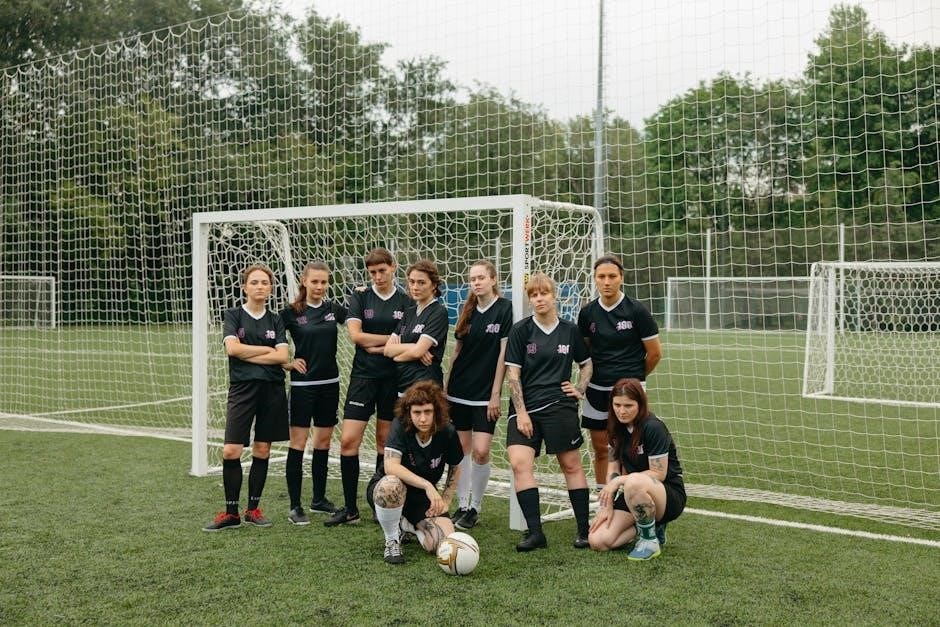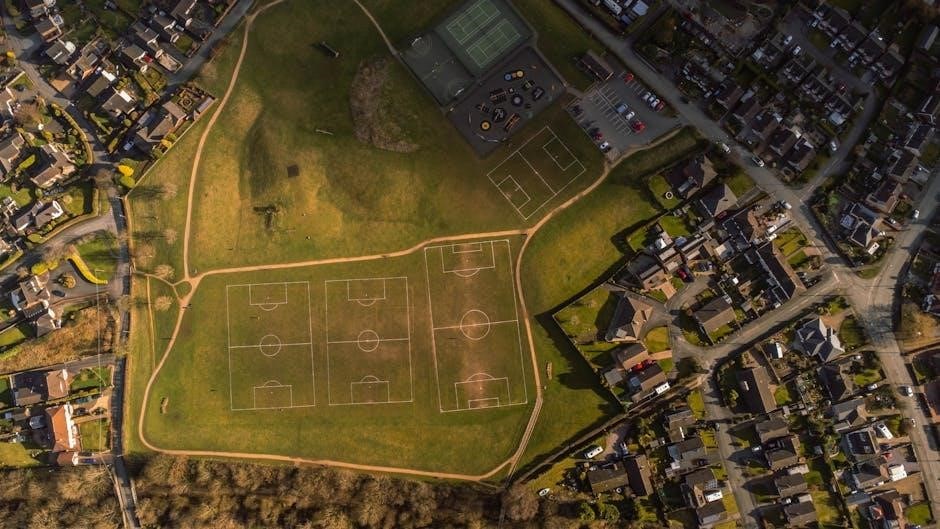Soccer Tryout Plan PDF: A Comprehensive Guide
This comprehensive guide offers insights into creating effective soccer tryout plans. Drawing from elite coaching methodologies, this guide assists in planning, choosing drills, and evaluating sessions for optimal player assessment.
Soccer tryout plans are essential for coaches to effectively evaluate players and build competitive teams. A well-structured plan ensures fair assessment and efficient use of time. This guide will help coaches develop robust tryout plans, focusing on key elements like format, schedule, and essential drills. Implementing appropriate drills, such as cone dribbling and small-sided games, is critical for assessing technical skills. Furthermore, understanding the importance of fun and engaging activities helps maintain player interest and motivation. This introduction emphasizes the need for detailed planning, ensuring every aspect of the tryout process contributes to identifying the best talent. Incorporating assessment drills allows for objective evaluation of player skills. Ultimately, a well-designed tryout plan is the cornerstone of successful team building.

Key Elements of a Successful Soccer Tryout
A successful soccer tryout hinges on a structured format, relevant drills, and comprehensive player evaluation. These elements help coaches identify talent and build a strong team effectively.
Establishing a Tryout Format and Schedule
Establishing a clear tryout format and schedule is crucial for a well-organized and effective player assessment. Determine the number of tryout days and the format each day will take. Consider incorporating skill demonstrations followed by practice sessions where players can showcase their abilities. A structured schedule ensures all players are evaluated fairly across various drills and game scenarios. Allocate specific time slots for each activity, including warm-ups, skill-based drills, and small-sided games.
Remember to communicate the schedule clearly to all participants beforehand. This will help manage expectations and allow players to prepare adequately. Designate specific areas for each activity to maximize space and efficiency. A well-defined format and schedule minimize confusion and maximize the evaluation process, ensuring a smooth and productive tryout experience for everyone involved.
Essential Soccer Tryout Drills
Essential soccer tryout drills should comprehensively assess players’ technical, tactical, and physical abilities. Incorporate drills focusing on dribbling, passing, receiving, and shooting to evaluate fundamental skills. Include small-sided games to observe decision-making, teamwork, and tactical awareness. Agility and fitness drills, such as cone drills and shuttle runs, measure speed, agility, and endurance.
Defensive drills, like 1-on-1 defending scenarios, assess players’ ability to win the ball and prevent opponents from scoring. Crossing and finishing drills evaluate attacking prowess and the ability to convert opportunities. Ensure the drills are age-appropriate and progressively challenging. Observation of players’ performance under pressure is key. These drills help identify players with the necessary skills and potential to contribute to the team. Remember that these drills are very important for you!

Specific Drill Examples for Soccer Tryouts
This section provides specific drill examples like 1-on-1 defending, 8-on-8 game simulations, agility drills, crossing and finishing exercises, and the Four In, Four Out drill.
1-on-1 Defending Drill
The 1-on-1 defending drill is crucial for evaluating a player’s ability to effectively challenge and dispossess an opponent. This drill assesses a player’s defensive technique, agility, and decision-making under pressure. The defender must demonstrate proper positioning, closing speed, and tackling ability. The attacker aims to beat the defender and score, testing the defender’s resilience and tactical awareness.
Coaches should observe the defender’s ability to stay low, maintain a balanced stance, and avoid lunging into tackles. The drill also highlights the defender’s communication skills and ability to anticipate the attacker’s moves. Successful defenders will exhibit composure, patience, and a relentless pursuit of the ball. This drill provides valuable insights into a player’s defensive capabilities.
8-on-8 Game Simulation
The 8-on-8 game simulation is an invaluable tool for assessing a player’s performance in a more realistic game setting. This format allows coaches to evaluate tactical awareness, decision-making, and teamwork. Players are tested on their ability to read the game, make quick decisions under pressure, and communicate effectively with teammates.
The simulation also provides insights into a player’s positional understanding, work rate, and ability to contribute both offensively and defensively. Coaches can observe how players adapt to different game situations, such as maintaining possession, transitioning from defense to attack, and supporting teammates. This simulation offers a comprehensive view of a player’s overall game intelligence and adaptability, crucial attributes for success.
Agility Focused Tryout Drills
Agility-focused tryout drills are essential for evaluating a player’s speed, coordination, and quickness. These drills assess a player’s ability to change direction rapidly, maintain balance, and react swiftly to stimuli. Incorporating cone drills, ladder drills, and shuttle runs can effectively measure a player’s agility and overall athleticism.
These drills not only highlight physical capabilities but also reveal a player’s mental agility, such as their ability to anticipate movements and react decisively. Agility is crucial for evading opponents, intercepting passes, and creating scoring opportunities. Observing players during these drills provides valuable insights into their potential to excel in dynamic game situations, emphasizing the importance of agility in soccer.
Crossing and Finishing Drills
Crossing and finishing drills are vital for assessing a player’s attacking prowess and ability to convert opportunities. These drills evaluate a player’s accuracy in delivering crosses, timing their runs into the box, and finishing with precision. Effective drills often involve wingers delivering crosses to forwards making runs, simulating game-like scenarios.
These drills also highlight a player’s ability to read the game, anticipate crosses, and position themselves effectively in the penalty area. Coaches can observe a player’s technique, decision-making, and composure under pressure. Crossing and finishing drills are essential for identifying players who can contribute to the team’s attacking success, showcasing their goal-scoring potential and overall offensive capabilities.
Four In, Four Out Drill
The “Four In, Four Out” drill is a dynamic and versatile exercise used to assess players’ decision-making, passing accuracy, and movement off the ball. This drill typically involves a square or rectangular playing area with four players inside and four players positioned outside as targets. The players inside aim to maintain possession by passing the ball among themselves, while the outside players provide support and act as passing options.
The objective is to complete a certain number of passes without losing possession. If the players inside lose the ball, they switch positions with the outside players. This drill emphasizes quick thinking, precise passing, and effective communication. Coaches can observe a player’s ability to make smart decisions under pressure and contribute to maintaining possession.

Evaluating Players During Tryouts
Effective evaluation during tryouts requires assessment drills to gauge player skills. Coaches can observe technical abilities, tactical understanding, and overall potential within a limited timeframe and make informed decisions.
Assessment Drills for Skill Evaluation
Skill evaluation during soccer tryouts is crucial for identifying talent and potential. Assessment drills should focus on core technical abilities, such as passing, dribbling, shooting, and receiving. These drills provide a structured environment to observe a player’s proficiency and decision-making under pressure. Coaches can use these drills to measure accuracy, speed, and control.
Observe how players handle the ball in tight spaces and their ability to execute passes with precision. Shooting drills assess striking technique and goal-scoring ability. Receiving drills evaluate a player’s first touch and their capacity to control the ball effectively.
Consider implementing drills that incorporate game-like scenarios. This helps evaluate a player’s tactical awareness, positioning, and ability to contribute to team play. These drills should be adapted to different age groups and skill levels, ensuring that players are challenged appropriately. Accurate skill assessment is vital for building a successful team.

Youth Soccer Drills and Games Integration
Integrating drills and games in youth soccer is key for skill development. Games make practice fun, enhancing skill carryover and engagement. This approach helps players learn and apply techniques effectively.
Incorporating Dribbling Drills with Cones
Dribbling drills with cones are fundamental for developing ball control, agility, and coordination in soccer players. A classic setup involves weaving through cones arranged in a straight line, zig-zag pattern, or circle. These drills enhance a player’s ability to maintain possession while maneuvering in tight spaces.
Variations include dribbling up to a cone and retreating, focusing on quick changes of direction. The emphasis is on maintaining close control of the ball and using different parts of the foot. Shielding the ball while dribbling around cones is also crucial, teaching players to protect the ball from opponents.
These drills should be demonstrated clearly before practice.
Utilizing Small-Sided Games for Skill Development
Small-sided games are invaluable for skill development, offering a dynamic environment to apply techniques learned in drills. These games encourage quick decision-making, spatial awareness, and teamwork. Incorporating small-sided games towards the end of practice is highly recommended.
These games should emphasize skills practiced during the session. Adapt the game to focus on specific areas, like passing accuracy or defensive positioning. Players enjoy these games, and the skills acquired are more likely to transfer to match situations.
Coaches can adapt rules to challenge players further. Small-sided games promote creativity and problem-solving skills, crucial for overall player development. The fun aspect keeps players engaged.
Considerations for Different Age Groups
When planning soccer tryouts, it is crucial to tailor the activities to the specific age group. Younger players benefit from shorter, more engaging drills that focus on fundamental skills. At the Learning to Train stage (U-8/U-11 Girls; U-9/U-12 Boys), technique drills should constitute a significant portion of practice time, roughly 40% of a 90-minute session.
Older players can handle more complex drills and game simulations. Consider their physical and cognitive development when designing the tryout format. Ensure drills are age-appropriate and challenging.
Adjust expectations based on the age group. Focus on effort and improvement for younger players. Assess tactical understanding and game awareness for older players.
The ultimate goal is to identify players with potential and a passion for soccer, regardless of age.
